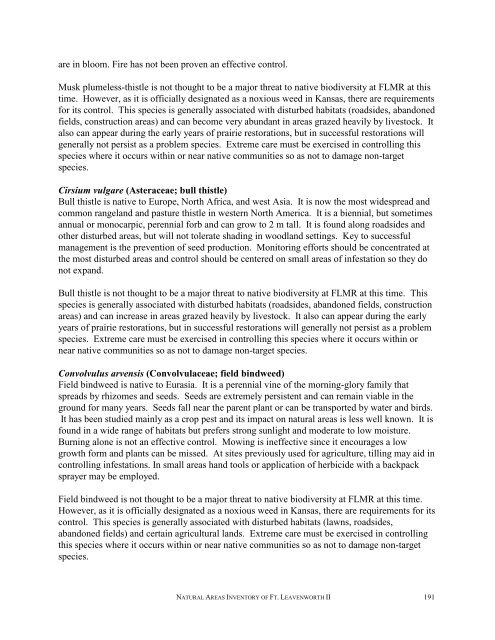A Natural Areas Inventory of the - Kansas Natural Heritage Inventory ...
A Natural Areas Inventory of the - Kansas Natural Heritage Inventory ...
A Natural Areas Inventory of the - Kansas Natural Heritage Inventory ...
You also want an ePaper? Increase the reach of your titles
YUMPU automatically turns print PDFs into web optimized ePapers that Google loves.
are in bloom. Fire has not been proven an effective control.<br />
Musk plumeless-thistle is not thought to be a major threat to native biodiversity at FLMR at this<br />
time. However, as it is <strong>of</strong>ficially designated as a noxious weed in <strong>Kansas</strong>, <strong>the</strong>re are requirements<br />
for its control. This species is generally associated with disturbed habitats (roadsides, abandoned<br />
fields, construction areas) and can become very abundant in areas grazed heavily by livestock. It<br />
also can appear during <strong>the</strong> early years <strong>of</strong> prairie restorations, but in successful restorations will<br />
generally not persist as a problem species. Extreme care must be exercised in controlling this<br />
species where it occurs within or near native communities so as not to damage non-target<br />
species.<br />
Cirsium vulgare (Asteraceae; bull thistle)<br />
Bull thistle is native to Europe, North Africa, and west Asia. It is now <strong>the</strong> most widespread and<br />
common rangeland and pasture thistle in western North America. It is a biennial, but sometimes<br />
annual or monocarpic, perennial forb and can grow to 2 m tall. It is found along roadsides and<br />
o<strong>the</strong>r disturbed areas, but will not tolerate shading in woodland settings. Key to successful<br />
management is <strong>the</strong> prevention <strong>of</strong> seed production. Monitoring efforts should be concentrated at<br />
<strong>the</strong> most disturbed areas and control should be centered on small areas <strong>of</strong> infestation so <strong>the</strong>y do<br />
not expand.<br />
Bull thistle is not thought to be a major threat to native biodiversity at FLMR at this time. This<br />
species is generally associated with disturbed habitats (roadsides, abandoned fields, construction<br />
areas) and can increase in areas grazed heavily by livestock. It also can appear during <strong>the</strong> early<br />
years <strong>of</strong> prairie restorations, but in successful restorations will generally not persist as a problem<br />
species. Extreme care must be exercised in controlling this species where it occurs within or<br />
near native communities so as not to damage non-target species.<br />
Convolvulus arvensis (Convolvulaceae; field bindweed)<br />
Field bindweed is native to Eurasia. It is a perennial vine <strong>of</strong> <strong>the</strong> morning-glory family that<br />
spreads by rhizomes and seeds. Seeds are extremely persistent and can remain viable in <strong>the</strong><br />
ground for many years. Seeds fall near <strong>the</strong> parent plant or can be transported by water and birds.<br />
It has been studied mainly as a crop pest and its impact on natural areas is less well known. It is<br />
found in a wide range <strong>of</strong> habitats but prefers strong sunlight and moderate to low moisture.<br />
Burning alone is not an effective control. Mowing is ineffective since it encourages a low<br />
growth form and plants can be missed. At sites previously used for agriculture, tilling may aid in<br />
controlling infestations. In small areas hand tools or application <strong>of</strong> herbicide with a backpack<br />
sprayer may be employed.<br />
Field bindweed is not thought to be a major threat to native biodiversity at FLMR at this time.<br />
However, as it is <strong>of</strong>ficially designated as a noxious weed in <strong>Kansas</strong>, <strong>the</strong>re are requirements for its<br />
control. This species is generally associated with disturbed habitats (lawns, roadsides,<br />
abandoned fields) and certain agricultural lands. Extreme care must be exercised in controlling<br />
this species where it occurs within or near native communities so as not to damage non-target<br />
species.<br />
NATURAL AREAS INVENTORY OF FT. LEAVENWORTH II 191


